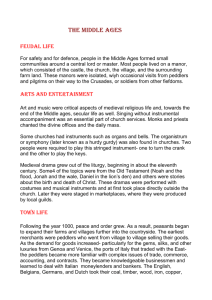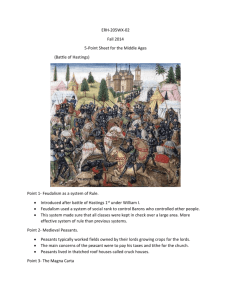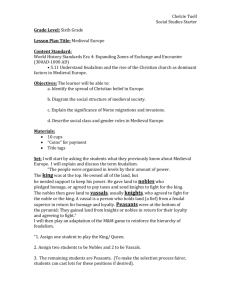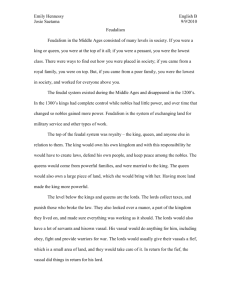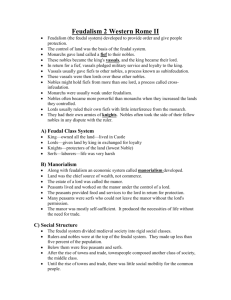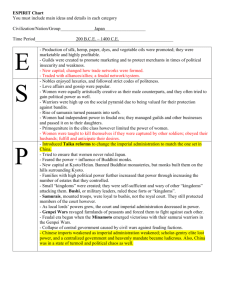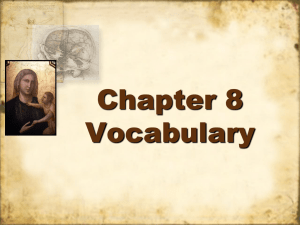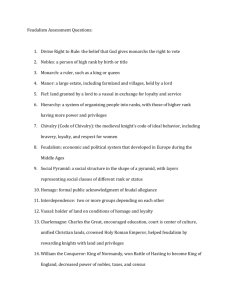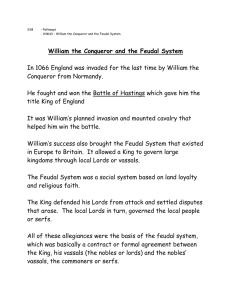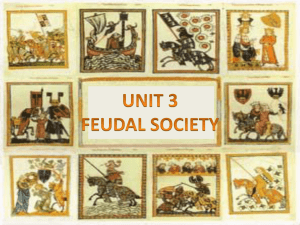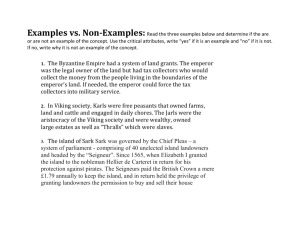Feudalism & Normans Worksheet: Middle Ages History
advertisement
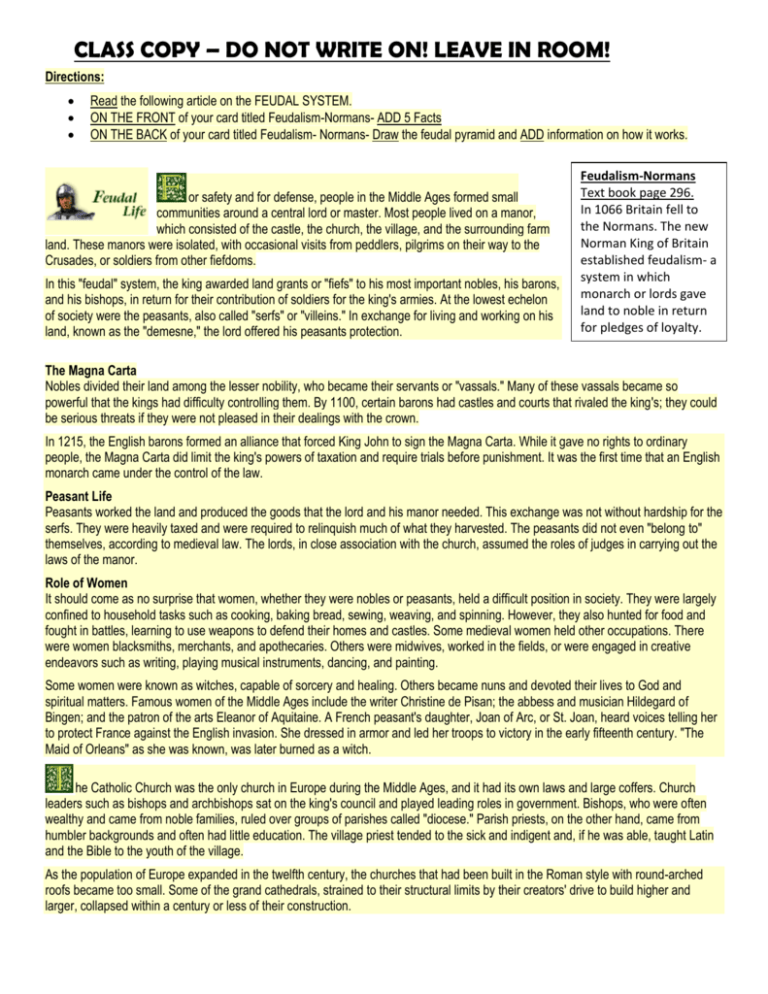
CLASS COPY – DO NOT WRITE ON! LEAVE IN ROOM! Directions: Read the following article on the FEUDAL SYSTEM. ON THE FRONT of your card titled Feudalism-Normans- ADD 5 Facts ON THE BACK of your card titled Feudalism- Normans- Draw the feudal pyramid and ADD information on how it works. or safety and for defense, people in the Middle Ages formed small communities around a central lord or master. Most people lived on a manor, which consisted of the castle, the church, the village, and the surrounding farm land. These manors were isolated, with occasional visits from peddlers, pilgrims on their way to the Crusades, or soldiers from other fiefdoms. In this "feudal" system, the king awarded land grants or "fiefs" to his most important nobles, his barons, and his bishops, in return for their contribution of soldiers for the king's armies. At the lowest echelon of society were the peasants, also called "serfs" or "villeins." In exchange for living and working on his land, known as the "demesne," the lord offered his peasants protection. Feudalism-Normans Text book page 296. In 1066 Britain fell to the Normans. The new Norman King of Britain established feudalism- a system in which monarch or lords gave land to noble in return for pledges of loyalty. The Magna Carta Nobles divided their land among the lesser nobility, who became their servants or "vassals." Many of these vassals became so powerful that the kings had difficulty controlling them. By 1100, certain barons had castles and courts that rivaled the king's; they could be serious threats if they were not pleased in their dealings with the crown. In 1215, the English barons formed an alliance that forced King John to sign the Magna Carta. While it gave no rights to ordinary people, the Magna Carta did limit the king's powers of taxation and require trials before punishment. It was the first time that an English monarch came under the control of the law. Peasant Life Peasants worked the land and produced the goods that the lord and his manor needed. This exchange was not without hardship for the serfs. They were heavily taxed and were required to relinquish much of what they harvested. The peasants did not even "belong to" themselves, according to medieval law. The lords, in close association with the church, assumed the roles of judges in carrying out the laws of the manor. Role of Women It should come as no surprise that women, whether they were nobles or peasants, held a difficult position in society. They were largely confined to household tasks such as cooking, baking bread, sewing, weaving, and spinning. However, they also hunted for food and fought in battles, learning to use weapons to defend their homes and castles. Some medieval women held other occupations. There were women blacksmiths, merchants, and apothecaries. Others were midwives, worked in the fields, or were engaged in creative endeavors such as writing, playing musical instruments, dancing, and painting. Some women were known as witches, capable of sorcery and healing. Others became nuns and devoted their lives to God and spiritual matters. Famous women of the Middle Ages include the writer Christine de Pisan; the abbess and musician Hildegard of Bingen; and the patron of the arts Eleanor of Aquitaine. A French peasant's daughter, Joan of Arc, or St. Joan, heard voices telling her to protect France against the English invasion. She dressed in armor and led her troops to victory in the early fifteenth century. "The Maid of Orleans" as she was known, was later burned as a witch. he Catholic Church was the only church in Europe during the Middle Ages, and it had its own laws and large coffers. Church leaders such as bishops and archbishops sat on the king's council and played leading roles in government. Bishops, who were often wealthy and came from noble families, ruled over groups of parishes called "diocese." Parish priests, on the other hand, came from humbler backgrounds and often had little education. The village priest tended to the sick and indigent and, if he was able, taught Latin and the Bible to the youth of the village. As the population of Europe expanded in the twelfth century, the churches that had been built in the Roman style with round-arched roofs became too small. Some of the grand cathedrals, strained to their structural limits by their creators' drive to build higher and larger, collapsed within a century or less of their construction. s the populations of medieval towns and cities increased, hygienic conditions worsened, leading to a vast array of health problems. Medical knowledge was limited and, despite the efforts of medical practitioners and public and religious institutions to institute regulations, medieval Europe did not have an adequate health care system. Antibiotics weren't invented until the 1800s and it was almost impossible to cure diseases without them. There were many myths and superstitions about health and hygiene as there still are today. People believed, for example, that disease was spread by bad odors. It was also assumed that diseases of the body resulted from sins of the soul. Many people sought relief from their ills through meditation, prayer, pilgrimages, and other nonmedical methods. The body was viewed as a part of the universe, a concept derived from the Greeks and Romans. Four humors, or body fliuds, were directly related to the four elements: fire=yellow bile or choler; water=phlegm; earth=black bile; air=blood. These four humors had to be balanced. Too much of one was thought to cause a change in personality--for example, too much black bile could create melancholy. ollowing 1000, peace and order grew. As a result, peasants began to expand their farms and villages further into the countryside. The earliest merchants were peddlers who went from village to village selling their goods. As the demand for goods increased--particularly for the gems, silks, and other luxuries from Genoa and Venice, the ports of Italy that traded with the East--the peddlers became more familiar with complex issues of trade, commerce, accounting, and contracts. They became savvy businessmen and learned to deal with Italian moneylenders and bankers. The English, Belgians, Germans, and Dutch took their coal, timber, wood, iron, copper, and lead to the south and came back with luxury items such as wine and olive oil. With the advent of trade and commerce, feudal life declined. As the tradesmen became wealthier, they resented having to give their profits to their lords. Arrangements were made for the townspeople to pay a fixed annual sum to the lord or king and gain independence for their town as a "borough" with the power to govern itself. The marketplace became the focus of many towns. Feudal Pyramid Feudalism is a social structure that gives everyone a job and place. This social structure wasn't really fair because you don't get to choose were you go once your ancestors were there you are likely to be. Feudalism is still a relationship between vassals and lords. From this system everyone helped each other like king gave nobles land then gave land for protection for both nobles and king. From there nobles got peasants that got protection and made food for everyone.
